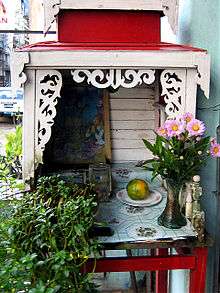Spirit house
A spirit house is a shrine to the protective spirit of a place that is found in the Southeast Asian countries of Burma, Cambodia, Laos, Thailand, Malaysia, Indonesia, and the Philippines. The spirit house is normally in the form of small roofed structure, and is mounted on a pillar or on a dais. They can range in size from small platforms to houses large enough for people to enter. Spirit houses are intended to provide a shelter for spirits that could cause problems for the people if not appeased. The shrines often include images or carved statues of people and animals. Votive offerings are left at the house to propitiate the spirits. More elaborate installations include an altar for this purpose.

In Indochina, most houses and businesses have a spirit house placed in an auspicious spot, most often in a corner of the property. The location may be chosen after consultation with a Brahmin priest. Spirit houses are known as နတ်စင် (nat sin) or နတ်ကွန်း (nat kun) in Burmese; ศาลพระภูมิ (san phra phum, 'house of the guardian spirit') in Thai; and rean tevoda ('place for the tevoda-spirit') or pteah phum in Khmer.
.jpg)
In maritime Southeast Asia, spirit houses are connected to the various traditional animistic rituals involving spirits. In the Philippines, spirit houses are dedicated to ceremonies or offerings involving the anito spirits. They are known magdantang in Visayan; ulango or simbahan in Tagalog; tangpap, pangkew, or alalot (for various small roofed altars), and balaua or kalangan (for larger structures) in Itneg; maligai in Subanen; tenin in Teduray; and buis (for those built near roads and villages) and parabunnian (for those built near rice fields) in Bagobo.[1][2][3]
Spirit house offerings
In Thailand, it is a long-standing tradition to leave offerings of food and drink at the spirit house. Rice, bananas, coconuts, and desserts are common offerings. Most ubiquitous is red, strawberry-flavoured Fanta.[4] The idea seems to be that friendly spirits will congregate to enjoy free food and drink and their presence will serve to keep more malign spirits at bay. The popularity of red Fanta offerings has existed for decades. Opinions as to "why Fanta?" vary. Most point to the significance of the colour red, reminiscent of animal sacrifice, or perhaps related to the practice of anchoring red incense sticks in a glass of water which promptly tints the water red. Sweetness is explained by the observation that sweet spirits naturally have sweet tooths.[5]
 A nat sin in downtown Yangon, Burma
A nat sin in downtown Yangon, Burma- Spirit house, Bangkok
- Spirit houses at a private house, Phetchaburi, Thailand
- Spirit houses protect a business, Thailand
 Spirit house, Hua Hin
Spirit house, Hua Hin.jpg) Cambodian-style spirit houses.
Cambodian-style spirit houses._the_pangkew%2C_two_tangpap%2C_and_an_alalot_(1922%2C_Philippines).jpg) Ceremonial spirit houses among the Itneg (lef to right) the pangkew, two tangpap, and an alalot (1922, Philippines)
Ceremonial spirit houses among the Itneg (lef to right) the pangkew, two tangpap, and an alalot (1922, Philippines).jpg) Kalangan spirit house, Itneg people (1922, Philippines)
Kalangan spirit house, Itneg people (1922, Philippines).jpg) A spirit house in Livingstonia, Malawi (c. 1910)
A spirit house in Livingstonia, Malawi (c. 1910)
See also
| Wikimedia Commons has media related to Spirit houses. |
References
- William Henry Scott (1994). Barangay: Sixteenth Century Philippine Culture and Society. Quezon City: Ateneo de Manila University Press. ISBN 9715501354.
- A. L. Kroeber (1918). "The History of Philippine Civilization as Reflected in Religious Nomenclature". Anthropological Papers of the American Museum of Natural History. XXI (Part II): 35–37.
- Fay-Cooper Cole & Albert Gale (1922). "The Tinguian; Social, Religious, and Economic life of a Philippine tribe". Field Museum of Natural History: Anthropological Series. 14 (2): 235–493.
- Bengali, Shashank (2019-04-18). "The spirit houses of Bangkok keep watch over a frenetic modern Thai city". Los Angeles Times. Retrieved 2019-04-20.
- Winn, Patrick (2017-04-06). "In Thailand, blood sacrifice is out. Strawberry Fanta is in". Public Radio International (PRI). Retrieved 18 August 2018.